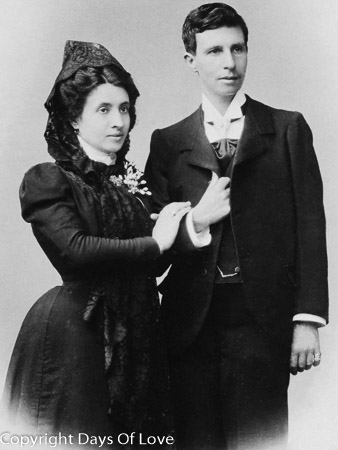

Wife Elisa Sanchez Loriga
 The
first same-sex marriage in Spain to take place after the Roman Imperial era
occurred on 8 June 1901.[1]
The
first same-sex marriage in Spain to take place after the Roman Imperial era
occurred on 8 June 1901.[1]
Two women, Marcela Gracia Ibeas (born June 27, 1867) and Elisa Sanchez Loriga, attempted to get married in A Coruña (Galicia, Spain).[2] To achieve it Elisa had to adopt a male identity: Mario Sánchez, as listed on the marriage certificate.[2] It is the first attempt at same-sex marriage in Spain for which there is recorded evidence.[1] It was performed by the Church, in the parish church of St. Jorge of the same city.[2][3] Subsequently, the parish priest discovered the deception, and was denounced and persecuted. Nevertheless, the marriage certificate was never annulled.
Their matrimonial union took place more than 100 years before the law would permit gay Spanish people to get married. The two worked as teachers at a time when the vast majority of the Galician population was illiterate.[2]
This event could be considered a precedent for same-sex marriage in Spain. News of their wedding was spread to all Spain and to various European countries. The couple is believed to have escaped to Argentina, and it is unknown what happened to them after that.
Marcela and Elisa met while studying in the Teacher-Training College for Teachers in A Coruña, where the future teachers of elementary education were educated.[1] Their friendship gave way to a more intimate relationship. Marcela's parents, seeing that the friendship was growing beyond what was socially permitted and fearing a possible scandal, sent their daughter to Madrid.[1] Time went by and both, one in A Coruña and the other in Madrid, finished their studies. They were reunited again when Elisa was appointed as a temporary teacher at Couso, a small parish of Coristanco in A Coruña.[1] Nearby, in Vimianzo, in the village of Calo, Marcela established herself already as a superior teacher.[1] As a consequence of the same, they decided to live together in Calo, where Elisa worked.[1] In 1889, Marcela had to go to teach classes at Dumbría while Elisa remained in Calo, but they stayed in contact until Elisa moved to the town where Marcela lived.[1]
In 1901, Elisa adopted a masculine appearance (with which she appeared in the Teaching College to apply for a certificate of study), fabricated a past, and was transformed into Mario.[2] For this invented past, she took as reference a cousin of hers killed in a shipwreck.[1] Furthermore, she made up that she had passed her childhood in London and that her father was an atheist.[1] Considering this last circumstance, Father Cortiella, parish priest of San Jorge, baptized Mario on 26 May 1901 (furthermore, he received first communion), and subsequently married the couple on 8 June 1901 after the publication of the banns.[2] The marriage ceremony was short; the sponsors bore witness to its validity; and the couple passed the night of the wedding in the boarding house Corcubión, on the street of San Andrés.[4]
Finally, the neighbours could not remain indifferent as before, with what was at the moment known as a "marriage without man".[4] The couple were exposed by Galician and Madrid newspapers and, as a consequence of this, both quickly lost their jobs, were excommunicated, and were issued an arrest warrant.[4] It appears that, so that the excommunication could take place, the parish priest requested a doctor examine Mario to check if he was a man or a woman.[5] Mario agreed. When the doctor issued his verdict, Mario attempted to pass for a hermaphrodite whose condition had been diagnosed in London.[5] The Civil Guard pursued the couple to the town of Dumbrías, where they both worked as teachers. There is evidence that they passed for Vigo and Oporto in their escape.[4] The last that is known of them is that they managed to board a ship destined for America (possibly Argentina, as so many other Spaniards of the era),[4] where they spent their honeymoon and, finally, stayed to live.[6] One of the cases that one of the courts took against them was closed. Several years later, some residents of Dumbría spread a rumour about the death of Elisa and the subsequent marriage of Marcela to a man.[7] This rumour has not been confirmed.
The wedding, according to the Diocesan Archive, is still valid, as neither the Church nor the civil registry annulled the marriage certificates, so this is the first recorded same-sex marriage in Spain.[8]
On 18 December 2008, the book Elisa e Marcela – Alén dos homes (Elisa and Marcela – Beyond men), by Narciso de Gabriel, was published in A Coruña.[9] The 300-page book, written in Galician, tells the story of the two women from the time they fled Coruña in 1901 until 1904. It narrates the events in Porto, Portugal, where they were imprisoned, tried, and later released. They fled to Argentina after the Spanish government demanded their extradition from Portugal.
Before leaving Porto for the Americas, Marcela gave birth to a girl. After they landed in Buenos Aires, Elisa (under the alias of Maria) married Christian Jensen, a man 24 years her senior, in 1903. Marcela, under the alias of Carmen, stayed there with his sister and her daughter.
After time, when Elisa refused to consummate the marriage with Christian, he became suspicious. Upon investigation, he discovered that Maria and Carmen were in fact Elisa and Marcela, which the press had realised long ago.
Once again, the courts were faced with trying to annul Jensen's marriage. Since the marriage was between a man and a woman, and therefore valid, no charges were brought against Elisa. After that time, in 1904, there no further record of Marcela and Elisa.
My published books: